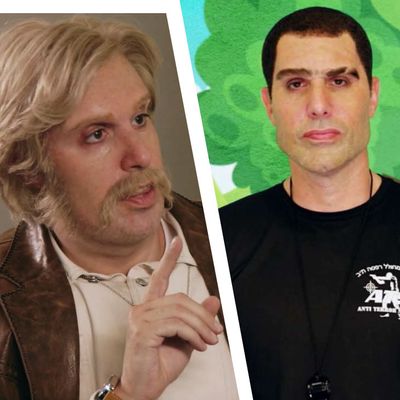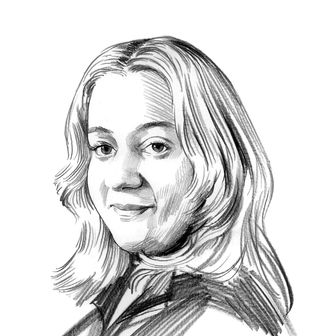
It seems like TV eons ago when we first witnessed Sacha Baron Cohen create a bunch of scat-tastic paintings and drop some fresh buggery beats at a nightclub all in the name of social commentary for his Showtime series Who Is America?, but none of these moments, political or otherwise, wouldÔÇÖve been possible if not for the wildly talented team behind CohenÔÇÖs face. Or rather, faces.
Led by veteran prosthetics and makeup artist Tony Gardner, the team had the colossal task of masking one of comedyÔÇÖs most recognizable personalities ÔÇö CohenÔÇÖs height and ÔÇ£iconicÔÇØ eyebrows didnÔÇÖt make it easy ÔÇö to help create six personas within the showÔÇÖs universe. These ranged from Erran Morad, a macho anti-terrorism expert who enjoys cajoling elected officials into dropping their pants, to Dr. Nira Cain-NÔÇÖDegeocello, a progressive feminist with a penchant for simulating childbirth. Regardless of the character, though, the goal was simple. ÔÇ£If the character isnÔÇÖt a believable, realistic character,ÔÇØ Gardner told Vulture, ÔÇ£the show literally ends.ÔÇØ
We recently hopped on the phone with Gardner to learn about this ÔÇ£uniqueÔÇØ experience, which took him to many different parts of the country. (As for Cohen, he has characterized GardnerÔÇÖs work as ÔÇ£unrivaledÔÇØ in the industry.) From 3 a.m. wake-up calls to emergency touch-ups during interviews, hereÔÇÖs what we discussed.
How did you become involved with this very secretive project?
I had previously done the show Jackass for MTV. Spike Jonze was a producer on that show, and I was hired to make up all of the showÔÇÖs actors in disguise so they could prank people. Jackass ended up getting a couple films, and one of the old-man characters we developed became its own spinoff called Bad Grandpa. The work we did for Johnny Knoxville and the film ended up getting nominated for an Academy Award for hair and makeup. Spike and I became friends, and he recommended me to Sacha a few years ago for whatever projects he would be working on in the future. We did a couple tests and moved forward with a partnership.
What did those test sessions look like? Did Sacha have strong ideas to begin with or was there room for experimentation?
In the beginning, it was a ÔÇ£sky is the limitÔÇØ approach. Sacha really didnÔÇÖt want to wear much of anything. His goal was to figure out the minimum amount of makeup and prosthetics required to make him unrecognizable. And it was hard. His eyebrows are iconic and instantly identifiable. His eyebrows are like Charlie ChaplinÔÇÖs mustache. ItÔÇÖs the hardest thing in the world to hide. Sacha is also very tall with a British accent. He doesnÔÇÖt blend in easily. We realized early on that his dream of wearing less wasnÔÇÖt really an option. We tested some characters in fewer prosthetics, like Gio, the Italian playboy character. We tried only using forehead prosthetics and hair pieces, and it didnÔÇÖt change SachaÔÇÖs silhouette enough to disguise him. Same with Erran with a wig, bald cap, and skin tone. Once Sacha stood up and started walking, everyone around him wasnÔÇÖt fooled. So we had to work in broader strokes from that point on.
How so?
When you talk to somebody, you look at their eyes and their mouth. So we had to break out contact lenses and dental veneers to change the look of those two areas. We worked backward ÔÇö everyone associates Sacha with a big head and dark hair, so letÔÇÖs change the shape of his head, too. We tested a lot of characters, and you saw maybe a third of what we were playing around with. If he wanted to do season two, he could put it together out of what he already has. He has tons more. But when we were testing the characters, the ones you see onscreen are the ones people responded to the most. It was interesting with Erran. People didnÔÇÖt want to let him down and they really wanted to please him; people wanted him to like them. He was very much an authority figure. Sacha called him an Israeli Ken doll on steroids.
What were some of the characters that were tested but ultimately cut?
YouÔÇÖre not gonna get that out of me! Who knows, thereÔÇÖs a chance they might come back. All IÔÇÖll say is, they were very entertaining. They really pushed the balance between reality and caricature.
When creating a character, what was the process like for you and Sacha? How collaborative was it?
It started with broad strokes. Sacha would be like, ÔÇ£Gio, this guy is an Italian playboy. Think of a guy who sails around a yacht in Italy, has a ton of tattoos, and kind of reminds you of Richard Branson. Erran, I want a unibrow and bulging muscles. HereÔÇÖs this random photo of an Israeli soldier I found on the internet.ÔÇØ WeÔÇÖd then pull reference photos or inspiration photos and see how it all fits together, and keep trading reference photos back and forth. We had a photo wall where we would chart our progress.
The goal is always not to bury Sacha, but I realized early on we had to obliterate his eyebrows. Shave ÔÇÿem off in order to get a blank slate. They sucked in the anatomy of his face. Taking somebodyÔÇÖs eyebrows off is difficult, obviously, but it allowed us to have a fuller range of characters to experiment with. That was a big hurdle for us, but Sacha was a good sport about it. From there, it was full steam ahead. We had hundreds of prosthetics and hairpieces we could play around with, mix and match. Remember, we didnÔÇÖt have the luxury of going to his interviews and being able to do a touch-up. WeÔÇÖd put everything on him and say, ÔÇ£See you in three hours.ÔÇØ HeÔÇÖs supposed to be a real person! So we had to be cognizant about not only where the prosthetics were placed, but how they worked with each other with other variables ÔÇö weather, humidity, where Sacha sweats, all that. If we were lucky, we could hide in a bathroom near the interview location so we could be available. But we didnÔÇÖt exist within the fake interview scenarios.
What was the experience like traveling with him to all of these super-high-pressure interviews? Was the mood generally stressful?
Oh, yeah, there was a lot of pressure. Sometimes you donÔÇÖt realize how stressed out you are until the day is over and a wave of exhaustion hits you. For us, if the makeup doesnÔÇÖt work, the showÔÇÖs over. The gag goes down the toilet. If the character isnÔÇÖt a believable, realistic character, the show literally ends as soon as the interviewee looks at him. The pressure is on us, which is terrifying! But, super exciting, and also an adrenaline rush. For example, when we were working in Washington, D.C. ÔÇö I worked with a small prosthetics team ÔÇö the night before we check into the hotel and our room turns into a makeup trailer. Dozens and dozens of luggage have to be unloaded and ready by 3 a.m. the next day, and then the makeup process would, on average, take about three hours. So, at 3 a.m., youÔÇÖd see us organizing everything and waiting for Sacha to come in. HeÔÇÖd have his notes and study his script while we made him up in the chair. He and his producers are also rewriting stuff, refining dialogue, and having meetings. HeÔÇÖs kind of in his own world, so we want to be quiet and respect that. It always feels like youÔÇÖre playing ÔÇ£beat the clock,ÔÇØ though. And thereÔÇÖs always tweaking until he walks out the door. The character is never fully done until he leaves.
The goal is, he walks out of the door and heÔÇÖs a completely believable human being, and thereÔÇÖs nothing off with the way he looks and talks. Over the course of a year of shooting, though, there were probably two or three times we had to do an emergency touch-up. You never know when somebody will grab his hair or something. And then, of course, weÔÇÖd have to wait until he came back to take everything off his face, so his skin would remain in good condition. It would usually take around 40 minutes for that. On an average day, weÔÇÖd be working 3 a.m. to 11 p.m. IÔÇÖm lucky that my kids are in college. In the past, I wouldnÔÇÖt be able to take a call and leave my house in a few hoursÔÇÖ notice to go to a random city. I had a ÔÇ£Sacha Go KitÔÇØ ready at all times. [Laughs.] So this job came at an opportune point in my life, too.
What were some of those close-call scenarios, and how did you overcome them?
One day with Gio, he was laughing a lot with his interviewee. His beard is tied onto lace because it looks best that way, and little by little, the beard began to disconnect from his face. There was a secret hand signal we had with producers when we were able to hide at the set, and we were hiding in a bathroom in this random penthouse. I was hiding behind a counter on the floor. Sacha excused himself to go to the bathroom, so I was able to reglue the beard and fluff it out again like nothing happened. Another time, we were filming at a boxing ring and the bathrooms were out of order. That was perfect! Nobody was gonna come in! But, as I mentioned, sometimes we were unable to be close to where they were filming. That nightclub in Florida, for instance, there was no way we couldÔÇÖve blended in there. Those times, you just gotta cross your fingers and hope for the best.
On average, how much did the prosthetics cost for one of these characters?
Oh my God, expensive. [Laughs.] In a way, all of the looks overlapped with the prosthetics that were used. Hundreds of thousands of dollars, close to a million, were probably spent for the show. A good wig will set you back $7,000. And sometimes weÔÇÖre not being the kindest to some of those hairpieces with the situations Sacha put himself in ÔÇö like, giving birth ÔÇö so we had to have backups for the backups. The thing most people realize is, you can only use prosthetics one time. They are in no way reusable. So, for a character like Rick Sherman, he had about a dozen cheek, chin, and forehead prosthetics that would be thrown out at the end of the day, and those were hundreds of dollars each.
I had such a great time. We were creating characters collectively ÔÇö we werenÔÇÖt on the exterior while Sacha was on the interior. Sacha could be inspired by something I or my team offhandedly said about a character. It felt like we were all part of this group, and when Sacha left to do an interview, it was a jolt of adrenaline to the heart. This show was probably the most unique experience IÔÇÖve ever had. I learned all about how to operate in the real world as a fake person.
This interview has been edited and condensed for clarity.


